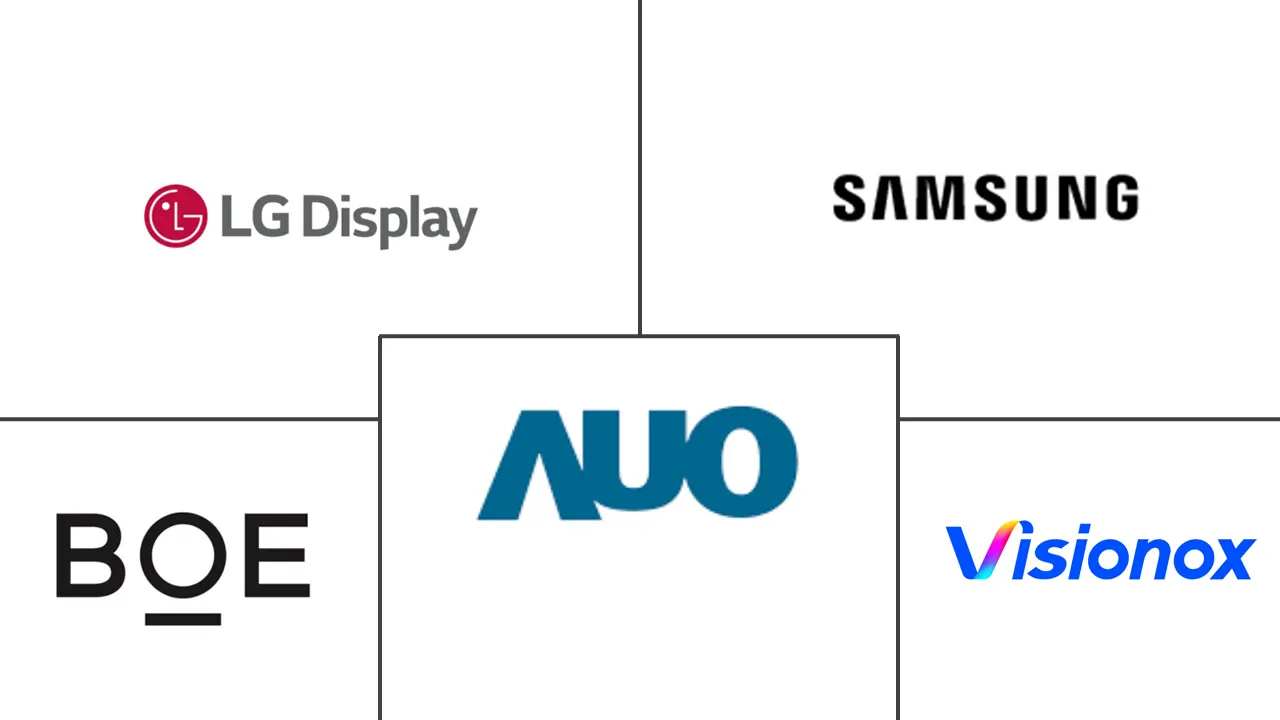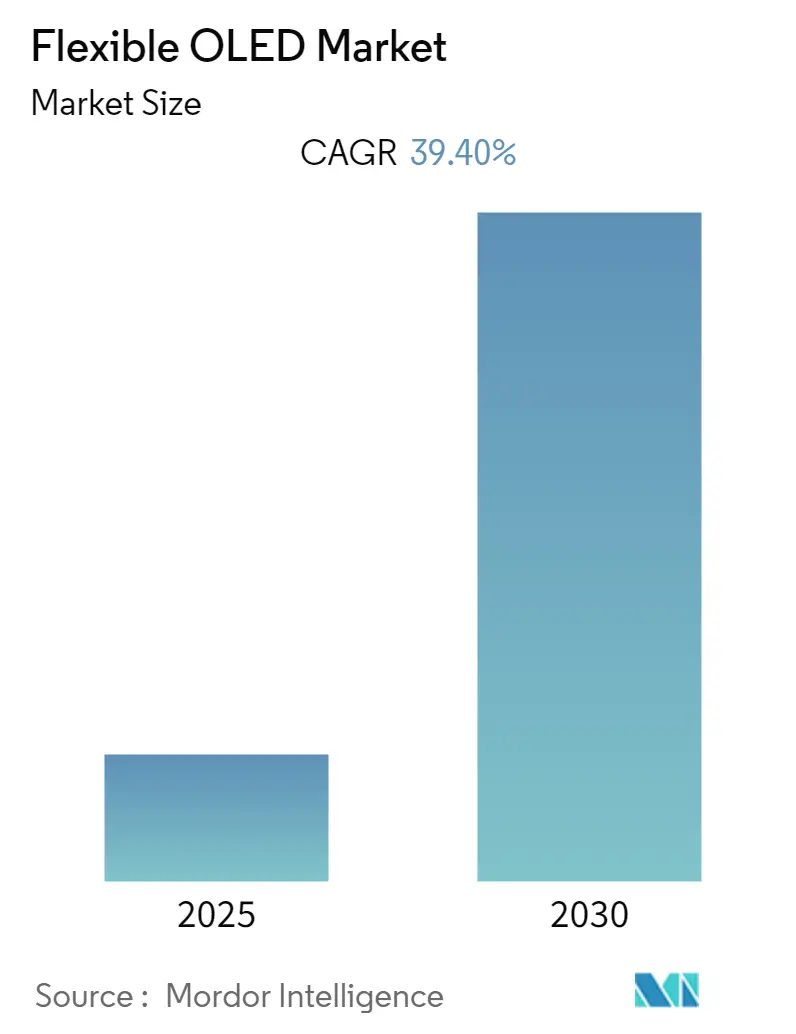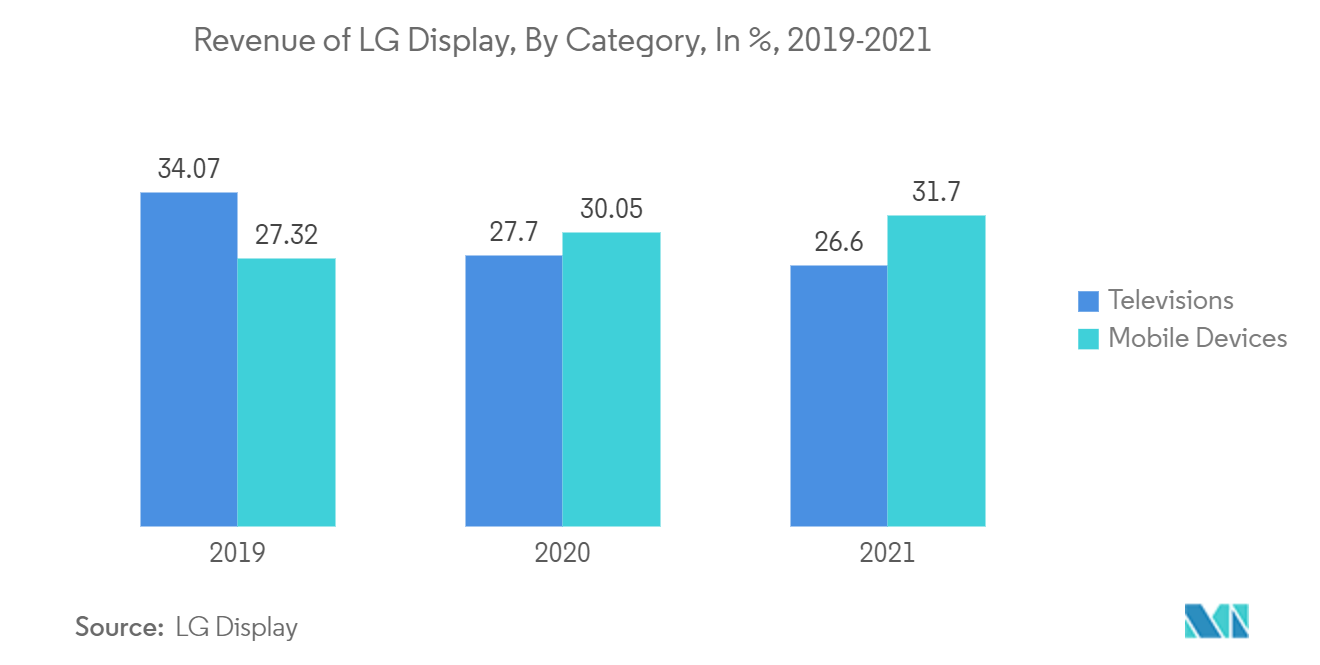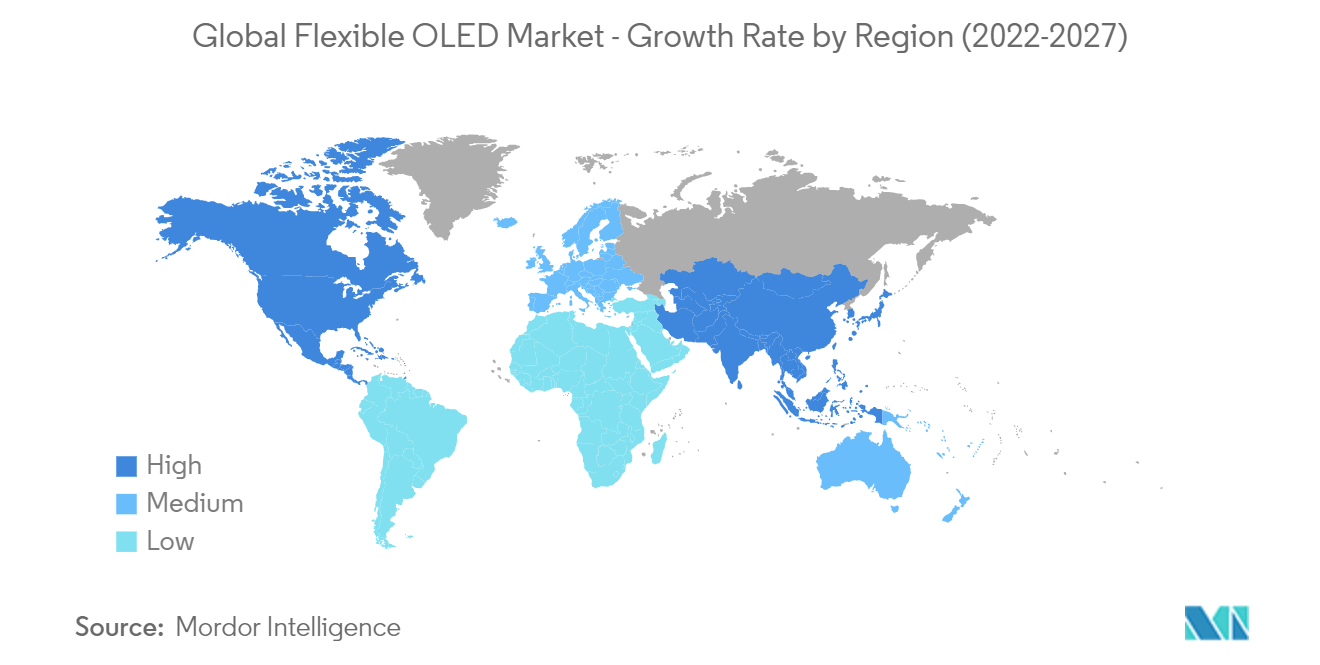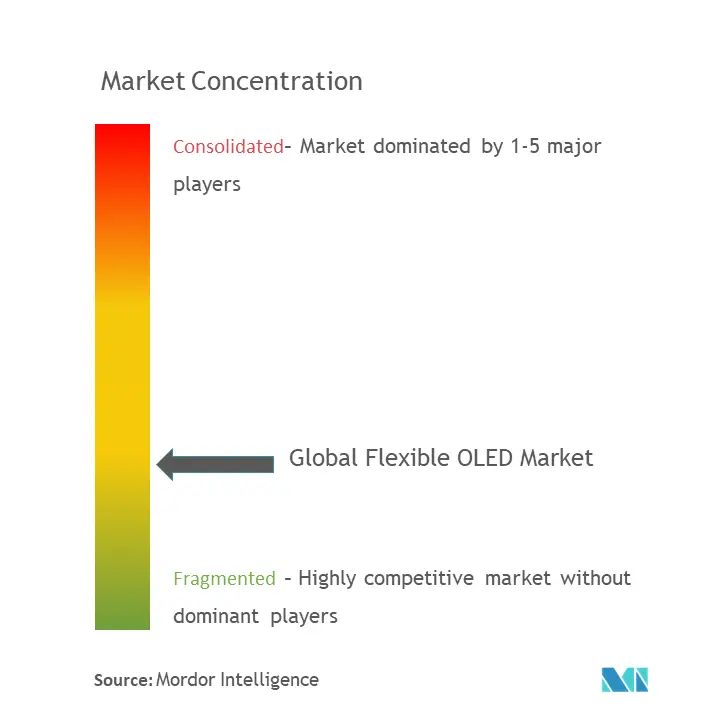Flexible OLED Market Analysis
The Flexible OLED Market is expected to register a CAGR of 39.4% during the forecast period.
- OLED is an emerging display technology that enables beautiful and efficient displays and lighting panels. OLEDs are already being used in many mobile devices and TVs, and the next generation of these panels will be flexible and bendable. OLEDs are the latest generation technology in the display industry and provide superior performance and enhanced optical characteristics compared to older LED and LCDs.
- The usage of flexible display technology in smartphones and tablets looks a bit unclear as with external factors such as user acceptability, protection and cost-effectiveness being some of the major challenges to be met by the smartphone companies, but it can find its wide usage in other industry such as automobiles and transportation.
- As of the recent developments Samsung Display plans to build a new 6-Gen flexible OLED line. The new line will replace a current LCD line that is used to produce TVs at SDC's Asan plant. The new fab, will cost around KRW 3 trillion or around USD 2.7 billion and will have a monthly capacity of 30,000 monthly substrates. This will increase Samsung Display AMOLED production capacity to 195,000 monthly substrates.
- Also, in November 2021, Samsung Displays, entered the medium-sized OLED market with the new high-refresh-rate displays for laptops. Samsung Display's flexible OLED screens can be folded, rolled, or slid. It feature high brightness, HDR10+ content playback, a low folding radius (R1.4), and better screen protection (UTG) compared to products from rival firms. The displays can be folded more than 200,000 times, equivalent to 100 folds and unfolds every day for five years.
- Further, the market is witnessing innovation. In January 2022, the customized 3D printing of a flexible organic light-emitting diode (OLED) display has been developed by a team from the University of Minnesota Twin Cities in the United States. The breakthrough, which is based on the conversion of electricity into light using an organic material layer, could lead to inexpensive OLED displays for handheld or wearable electronics made at home using 3D printers.
- COVID-19 has had a detrimental influence on the market as a result of several cities being shut down, causing damage to the supply chain for phone and display production, and reducing smartphone sales around the world. With more strict measures being imposed by governments throughout the world, the lockdown, which has brought economic activity to a halt, is projected to have a stronger impact in the near future. A lengthy lockdown has resulted in the temporary closure of factories, causing production and shipping of commodities to be hampered.
Flexible OLED Market Trends
Mobiles and Televisions to Witness Significant Growth
- With increased smartphone adoption globally, the demand for high-definition ultra-high displays is growing quickly. With many companies, such as Apple and Samsung employing AMOLED displays in their flagship models, other companies are following the trend.
- But still, a flexible OLED provides several advantages, especially in mobile devices, such as lighter, thinner, and more durable displays than glass-based displays. These proved to be an important asset for mobile phone manufacturers, as they provided better performance, durability, and a reduction in weight.
- For instance, in May 2022, LG Display Co. Ltd announced bringing its next-generation OLED solutions to the 2022 Society for Information Display (SID) conducted in San Jose, California. The products included OLED.EX to Bendable and Foldable OLED panels. This innovation is expected to solidify the company's OLED leadership in the market studied.
- Additionally, in January 2022, the company announced to be preparing to supply OLED panels for the apple iPad by 2024. The company is planning to ramp up production in 2024, and it is expected that the first OLED iPad will undergo manufacturing before that.
- Further, various companies have been releasing smartwatches with flexible displays to stay ahead of the competition. In July 2020, the Nubia watch was released with a flexible AMOLED screen and eSIM support, among other features. The display is a 4.01-inch (960x192 pixels) flexible, bendable OLED display with 244ppi pixel density.
Asia-Pacific to Witness the Fastest Growth Rate
- The economies of major countries like India and China are growing, leading to an increase in the disposable incomes of consumers. Hence, moving toward adopting high-end electronic products, such as curved televisions and premium smartphones. Thus, driving the flexible OLED market in the region.
- For instance, in June 2021, Samsung announced the development of a flexible OLED display that could be invaluable to future wearable devices that can be stuck to the skin and conform to its surface. To create a flexible display, Samsung created individual OLED pixels that themselves are ridged and sit on a flexible elastomer surface. Connections between the OLEDs are made using a flexible material, as are the traces that connect the display to the driver system.
- Moreover, Chinese companies are moving quickly to set up large-scale production bases to churn out OLEDs. BOE is constructing a production plant for smaller OLEDs in the southwestern Chinese city of Chongqing. The OLED production line is the largest for a single factory in China, producing 115 million panels annually.
- Also, the Tech giant, Apple Inc., is investing in developing its foldable phone and has planned to start the assembly plant in India for premium iPhones. The commencement of this plant will make its phones available at cheaper rates than it is in the country. Hence, the demand will drive the growth of the flexible OLED market in the region.
Flexible OLED Industry Overview
The Global Flexible OLED Market is very competitive in nature. The market is concentrated due to the presence of various small and large players. All the major players account for a large share of the market and are focusing on expanding their consumer base across the world. Some of the significant players in the market are LG Display Co. Ltd, Samsung Electronics Co., Ltd., AU Optronics Corp., BOE Technology Group Co Ltd, RiTdisplay Corp, Universal Display Corporation, Visionox Company, and many more. The companies are increasing the market share by forming multiple partnerships and investing in introducing new products to earn a competitive edge during the forecast period.
- June 2022 - LG Display has teamed up with the global architecture and design firm Gensler to introduce the Maars M923., a next-generation Transparent OLED partition. By applying the OLED technology, the Maars M923 offers a unique balance of openness and privacy, redefining space and the dimensions of visual presentations with the option of either transparency or vivid colours without the need for a separate TV or monitor.
- June 2022 - Samsung electronics co ltd acquired Cynora Gmbh. Cyonara is developing a new type of organic emitting materials for OLED displays based on TADF (Thermally Activated Delayed Fluorescence) technology. With this technology, the company will be able to commercialize the first high-efficiency blue emitting material on the market, which is the most sought-after material by OLED display makers.
Flexible OLED Market Leaders
-
LG Display Co.,Ltd.
-
Samsung Electronics Co. Ltd
-
BOE Technology UK Limited
-
AUO Corporation
-
Visionox Company
- *Disclaimer: Major Players sorted in no particular order
Flexible OLED Market News
- June 2022 - LG Display creates new markets with cutting-edge OLED solutions. The company launched upgraded versions of G2& C2 televisions. Both versions are making use of upgraded OLED technology to create even better visuals. This technology enables the displays to deliver higher brightness with greater clarity and detail. The new sizes of the G2 series are introduced alongside three other sizes (55", 65", and 77"). The C2 series gets a total of 6 display sizes.
- February 2022 - Visionox released China's first 1Hz low-power AMOLED display, which can achieve a dynamic refresh rate of 1-120 Hz through Hybrid-TFT technology. At the same time, mobile phones equipped with the company's 1Hz low-power AMOLED display will also be released soon. Hybrid -TFT technology helps in a significant reduction in power consumption. The Hybrid-TFT low-power technology was mass-produced by China's first fully flexible high-definition Visionox (Hefei) G6 AMOLED production line, which is positioned as the future-oriented high-end display technology.
Flexible OLED Industry Segmentation
The Global Flexible OLED Market is segmented by Technology (AMOLED, PMOLED), by Application (Mobiles and Tablets, Monitors and TV's, Wearables), and by Geography. The flexible OLED technology provides high definition quality with a wide range of applications. The scope of the study for the flexible OLED market has considered both OLED technologies and the respective end-user application across regions in the world.
| By Technology | AMOLED |
| PMOLED | |
| By Application | Mobiles and Tablets |
| Monitors and TVs | |
| Wearables | |
| Other Applications | |
| By Geography | North America |
| Europe | |
| Asia-Pacific | |
| Latin America | |
| Middle East & Africa |
Flexible OLED Market Research FAQs
What is the current Flexible OLED Market size?
The Flexible OLED Market is projected to register a CAGR of 39.4% during the forecast period (2025-2030)
Who are the key players in Flexible OLED Market?
LG Display Co.,Ltd., Samsung Electronics Co. Ltd, BOE Technology UK Limited, AUO Corporation and Visionox Company are the major companies operating in the Flexible OLED Market.
Which is the fastest growing region in Flexible OLED Market?
Asia Pacific is estimated to grow at the highest CAGR over the forecast period (2025-2030).
Which region has the biggest share in Flexible OLED Market?
In 2025, the Asia Pacific accounts for the largest market share in Flexible OLED Market.
What years does this Flexible OLED Market cover?
The report covers the Flexible OLED Market historical market size for years: 2019, 2020, 2021, 2022, 2023 and 2024. The report also forecasts the Flexible OLED Market size for years: 2025, 2026, 2027, 2028, 2029 and 2030.
Our Best Selling Reports
Flexible OLED Industry Report
Statistics for the 2025 Flexible OLED market share, size and revenue growth rate, created by Mordor Intelligence™ Industry Reports. Flexible OLED analysis includes a market forecast outlook for 2025 to 2030 and historical overview. Get a sample of this industry analysis as a free report PDF download.

